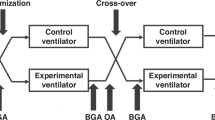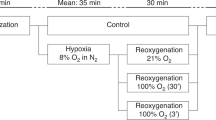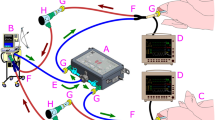Abstract
ABSTRACT: Several amino acids (AA) act as neurotrans—mitters and mediate the ventilatory response to carbon dioxide and hypoxia in adult human beings and animals. To evaluate the influence of AA on the neonatal ventilatory response to hypoxia, 29 newborn piglets less than 5 d old were randomly assigned to a control diet or protein-free diet for 7–10 d. Minute ventilation, arterial blood pressure, oxygen consumption, and arterial blood gases were measured in sedated, spontaneous breathing piglets while they breathed room air and at 1, 5 and 10 min of hypoxia (fraction of inspired oxygen concentration — 0.10) before and after 4 h of AA (Trophamine, 3 g/kg, i.v.) or 10% dextrose infusion. The administration of AA solution in protein-deprived piglets resulted in a significant increase in minute ventilation after 10 min of hypoxia (26 ± 19%) in comparison with their ventilatory response before AA infusion (10 ± 12%; p < 0.02). Similar increase in the ventilatory response to hypoxia was observed in the control diet group after A A infusion (23 ± 17% versus 11 ± 11%; p < 0.05). Changes in arterial blood pressure, oxygen consumption, and arterial blood gases during hypoxia were similar before and after AA infusion. The ventilatory response to hypoxia in both protein-free and control diet animals were similar before and after the 10% dextrose infusion. These results stress the importance of nutritional factors in the neonatal control of breathing.
Similar content being viewed by others
Log in or create a free account to read this content
Gain free access to this article, as well as selected content from this journal and more on nature.com
or
Author information
Authors and Affiliations
Rights and permissions
About this article
Cite this article
Soliz, A., Suguihara, C., Huang, J. et al. Effect of Amino Acid Infusion on the Ventilatory Response to Hypoxia in Protein-Deprived Neonatal Piglets. Pediatr Res 35, 316–320 (1994). https://doi.org/10.1203/00006450-199403000-00007
Received:
Accepted:
Issue date:
DOI: https://doi.org/10.1203/00006450-199403000-00007



